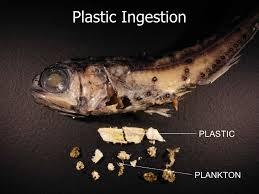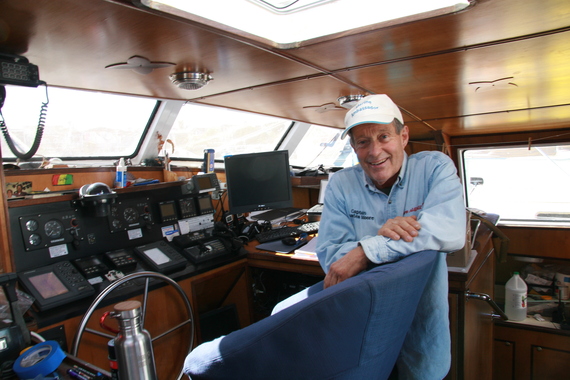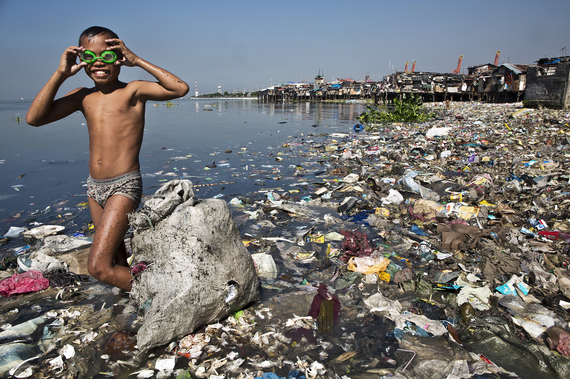Published in the Huffington Post by Belinda Waymouth January 27, 2015
The day of ecological reckoning looms over us. I am not talking about
whether the Keystone XL Pipeline gets rammed through our backyards. I
am down the rabbit hole of environmental concern with another
problematic petrochemical -- plastic.
We get plastic from oil,
and have ingeniously transformed this hydrocarbon polymer into a
multitude of plastic things, giving our lives a facade of
durable-but-lightweight convenience.
Meantime there's mounting evidence the dark side of plastic is much more than we bargained for, or can cope with.
First
off, the wholesale recyclability of plastic is a happy ending
environmental types -- such as your author -- want to believe. But in
the U.S less than 10 percent of plastic gets recycled. And, even when it is recycled, the amount has become overwhelming. Globally there'll be 45 million tons of plastic scrap looking to be recycled this year.
Most
scrapped plastic ends up in China, bound for the Wen'an region. Once a
bucolic piece of countryside, Wen'an is now a toxic cesspit, where
people are paralyzed by off-the-chart blood pressure problems, after
enduring horrendous work conditions in a bid to recycle -- or otherwise
dispose of -- all the plastic.
What can't be recycled is burnt, releasing dioxins -- the worst of the worst toxins. Dioxins
are carcinogenic, linked to developmental and reproductive impairment,
heart disease, diabetes, and in extreme cases of exposure a nasty skin
ailment - chloracne.
Next inconvenient truth -- a huge amount of
our plastic debris ends up in the ocean. Last months first scientific
accounting of total ocean plastic pollution estimates the amount at a
mind boggling 5.25 trillion pieces. Plastic only started becoming a household item in the 1950's, so this amount of trashed plastic happened in 60 odd years.
Almost
as worrisome, these researchers found 100 times fewer micro-sized
plastic particles than expected. Because that's another pesky thing
about plastic, it does NOT biodegrade, it photodegrades -- meaning in sunlight plastic simply breaks
into smaller and smaller pieces, which are nearly impossible to detect
but have huge and brutal consequences as they enter the food chain.
Which brings us to one of the worlds tiniest but most significant fish species: Myctophids, aka Lanternfish, account for over half of the oceans fishy biomass, and are apparently scoffing down plastic like there's no tomorrow.
Iddy
biddy fish ingesting miniscule particles of plastic might not sound too
awful. Until now these four to five centimeters long, two to five grams
fishes were seen as inferior to our other little finned friends - the
sardine or anchovy. Myctophids were ground into fodder for industrial
fish farms. However the line from plastic-gobbling Myctophids to your
next meal is about to get a lot more direct.
Some in the fishing industry see huge potential
for this "untouched resource" and are developing methods to convert
this plentiful, but low value fish, into a high value-added product.
Ungutted Myctophids will be processed into surimi (the Japanese
term for mechanically deboned fish mince) with uses ranging from fish
products, to meat substitutes, and dessert dishes.
It would seem ecological folly to mess with a fish species that is the very basis of important marine food webs - swordfish, tuna, dolphins and seals eat Myctophids.
Not
to mention the risk taken if we ingest plastic -- a possibility that is
in the news more and more these days. Last fall scientists discovered
there are microplastics in two-dozen German beers and European shellfish lovers ingest 11,000 pieces of plastic a year in their pursuit of gastronomic nirvana.
Apart
from how unappetizing eating or drinking plastic sounds, it's all the
nasty chemicals in plastic (phthalates - known endocrine disruptors -
are used to soften plastic) and that adhere to plastic so eagerly in the
marine environment (POPs, DDT and flame retardants) that make it highly toxic.
But now for the good news: with this growing pile of evidence about the pervasiveness of plastic pollution, we can take action.
This
is the moment to change our reliance on the not-so-disposable-after-all
polymer. If we can move beyond a single-use throw-away mentality, and
incentivize the plastics industry to design effective end-game
recyclability into their products - the size of the problem will begin
to diminish.
Which is precisely what's needed to assist less discerning species cope with our plastic mess.
Captain Charles Moore of Algalita Marine Research and Education, describes himself as the ocean's "voluntary public defender" - The Lorax
who speaks for the seas, if you will. He says organisms can't cope with
plastic because it's happened too quickly, "people think stupid
myctophids to eat plastic, but evolutionarily speaking they have no
selection process to avoid to it."
Myctophids
are Captain Moore's "Humming-Fish" but unlike the fictional Lorax he
can't send them away to an ocean without plastic -- that ocean no longer
exists.
Crafty little guys, Myctophids, stay low in the water
column during daylight avoiding predation, then rise to feed on
zooplankton at the ocean surface during the darkest hours of night.
To aid in this diel migration, Myctophids have swim bladders
that alter their buoyancy as required. But what will happen to this
mechanism in a fish that has a belly full of flotation devices - plastic
particles.
If it hasn't been incinerated, every piece of plastic
ever produced is still with us. There is no time for any species to
biologically adapt to cope with plastic, including us. We have to make
an effort to culturally evolve with way less plastic.
Put another way: think long and hard about what you want to be eating and gazing upon in the days to come.



No comments:
Post a Comment
Note: Only a member of this blog may post a comment.